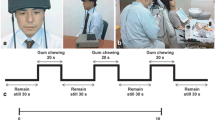Abstract
In elderly persons, it is thought that maintenance of masticatory function may have a beneficial effect on maintenance of cerebral function. However, few studies on cerebral circulation during mastication exist. This study aimed to verify a possible increase in cerebral circulation and the presence of cerebral hemispheric dominance during gum chewing. Twelve healthy, young right-handed subjects with normal dentition were enrolled. Bilateral middle cerebral arterial blood flow velocities (MCAV), heart rate, and arterial carbon dioxide levels were measured during a handgrip exercise and gum chewing. During gum chewing, electromyography of the bilateral masseter muscle was recorded.MCAV and heart rate significantly increased during exercise compared to values at rest.During gum chewing, there were no differences in the rate of increase in MCAV between the working and non-working sides, but during the handgrip exercise, the rate of increase in MCAV was significantly greater for the non-working side than for the working side.During gum chewing,muscle activity on the working side was significantly greater than that on the non-working side. These results suggest that during gum chewing, cerebral circulation increases bilaterally and does not show contralateral dominance, as it does during the handgrip exercise.
Similar content being viewed by others
References
Aaslid R, Lindegaard KF, Sorteberg W, Nornes H (1989) Cerebral autoregulation dynamics in humans. Stroke 20:45-2
Aaslid R, Markwalder TM, Nornes H (1982) Noninvasive transcranial Doppler ultrasound recording of flow velocity in basal cerebral arteries. J Neurosurg 57:769-74
Borbey K, Gjedde A,Nyáry I, Czirják S, Donauer N, Buck A (2003) Speech activation of language dominant hemisphere: a single-photon emission computed tomography study. Neuroimage 20:987-94
Dahl A, Lindegaard KF, Russell D, Nyberg-Hansen R, Rootwelt K, Sorteberg W, Nornes H (1992) A comparison of transcranial Doppler and cerebral blood flow studies to assess cerebral vasoreactivity. Stroke 23:15-9
Friedman DB, Friberg L, Mitchell JH, Secher NH (1991) Effect of axillary blockade on regional cerebral blood flow during static handgrip. J Appl Physiol 71:651-56
Friedman DB, Friberg L, Payne G, Mitchell JH, Secher NH (1992) Effects of axillary blockade on regional cerebral blood flow during dynamic hand contractions. J Appl Physiol 73: 2120-125
Hall JL,Humbertson AO (1968) The autonomic nervous system. Prog Neurol Psychiatry 23:253-70
Hasegawa Y, Ono T,Hori K,Nokubi T (2007) Influence of human jaw movement on cerebral blood flow. J Dent Res 86:64-8
Jørgensen LG, Perko G, Payne G, Secher NH (1993) Effect of limb anesthesia on middle cerebral response to handgrip. Am J Physiol 264:H553–H559
Keith A (1992) Anatomy and freehand examination techniques. In: Newell DW (ed) Transcranial Doppler. Raven Press,New York, pp 9-1
Lin SK, Chang YJ, Ryu SJ, Chu NS (2002) Cerebral hemodynamic responses to betel chewing: a Doppler study. Clin Neuropharmacol 25:244-50
Markwalder TM, Grolimund P, Seiler RW, Roth F, Aaslid R (1984) Dependency of blood flow velocity in the middle cerebral artery on end-tidal carbon dioxide partial pressure -a transcranial ultrasound Doppler study. J Cereb Blood Flow Metab 4:368-72
Mizumori T, Tsubakimoto T, Iwasaki M,Nakamura T (2003) Masticatory laterality–evaluation and influence of food texture. J Oral Rehabil 30:995-99
Momose I, Nishikawa J, Watanabe T, Sasaki Y, Senda M,Kubota K, Sato Y, Funakoshi, M, Minakuchi S (1997) Effect of mastication on regional cerebral blood flow in humans examined by positron-emission tomography with 15O-labelled water and magnetic resonance imaging. Arch Oral Biol 42:57-1
Oldfield RC (1971) The assessment and analysis of handedness: the Edinburgh inventory. Neuropsychologia 9:97-13
Onozuka M, Fujita M, Watanabe K, Hirano Y, Niwa M, Nishiyama K, Saito S (2002) Mapping brain region activity during chewing: a functional magnetic resonance imaging study. J Dent Res 81:743-46
Onozuka M, Fujita M, Watanabe K, Hirano Y, Niwa M, Nishiyama K, Saito S (2003) Age-related changes in brain regional activity during chewing: a functional magnetic resonance imaging study. J Dent Res 82:657-60
Onozuka M, Watanabe K, Mirbod SM, Ozono S,Nishiyama K,Karasawa N, Nagatsu I (1999) Reduced mastication stimulates impairment of spatial memory and degeneration of hippocampal neurons in aged SAMP8 mice. Brain Res 826:148-53
Saito M (2000) Exercise-induced sympathetic activation is correlated with cerebral hemisphere laterality, but not handedness. Acta Physiol Scand 170:111-18
Sesay M, Tanaka A, Ueno Y, Lecaroz P, De Beaufort DG (2000) Assessment of regional cerebral blood flow by xenonenhanced computed tomography during mastication in humans. Keio J Med 49(Suppl 1):A125–A128
Shinagawa H, Ono T, Honda E, Sasaki T, Taira M, Iriki A, Kuroda T, Ohyama K (2004) Chewing-side preference is involved in differential cortical activation patterns during tongue movements after bilateral gum-chewing: a functional magnetic resonance imaging study. J Dent Res 83:762-66
Shinagawa H, Ono T, Ishiwata Y,Honda E, Sasaki T, Taira M, Iriki A, Kuroda T (2003) Hemispheric dominance of tongue control depends on the chewing- side preference. J Dent Res 82:278-83
Sitzer M, Knorr U, Seitz RJ (1994) Cerebral hemodynamics during sensorimotor activation in humans. J Appl Physiol 77:2804-811
Sonnenschein RR, White FN (1968) Systemic circulation: local control. Annu Rev Physiol 30:147-70
Sugiyama K, Okumura C, Watanabe S (1999) Validation of transcranial Doppler method to evaluate the effects of mastication on cerebral blood flow. Jpn J Nurs Res 32:473-82
Yamamoto T, Hirayama A (2001) Effects of soft-diet feeding on synaptic density in the hippocampus and parietal cortex of senescence-accelerated mice. Brain Res 902:255-63
Author information
Authors and Affiliations
Corresponding author
Rights and permissions
About this article
Cite this article
Ono, T., Hasegawa, Y., Hori, K. et al. Task-induced activation and hemispheric dominance in cerebral circulation during gum chewing. J Neurol 254, 1427–1432 (2007). https://doi.org/10.1007/s00415-007-0570-3
Received:
Revised:
Accepted:
Published:
Issue Date:
DOI: https://doi.org/10.1007/s00415-007-0570-3




